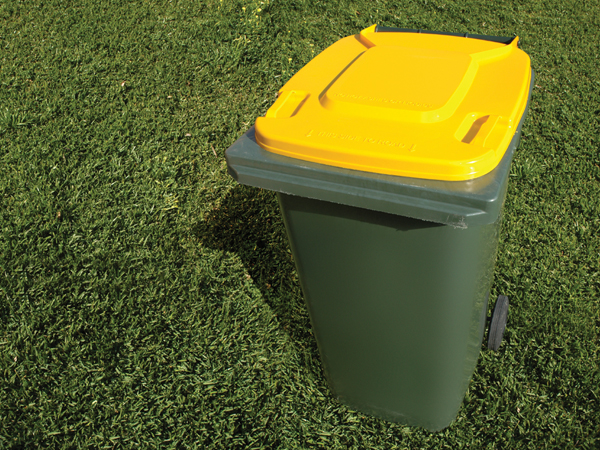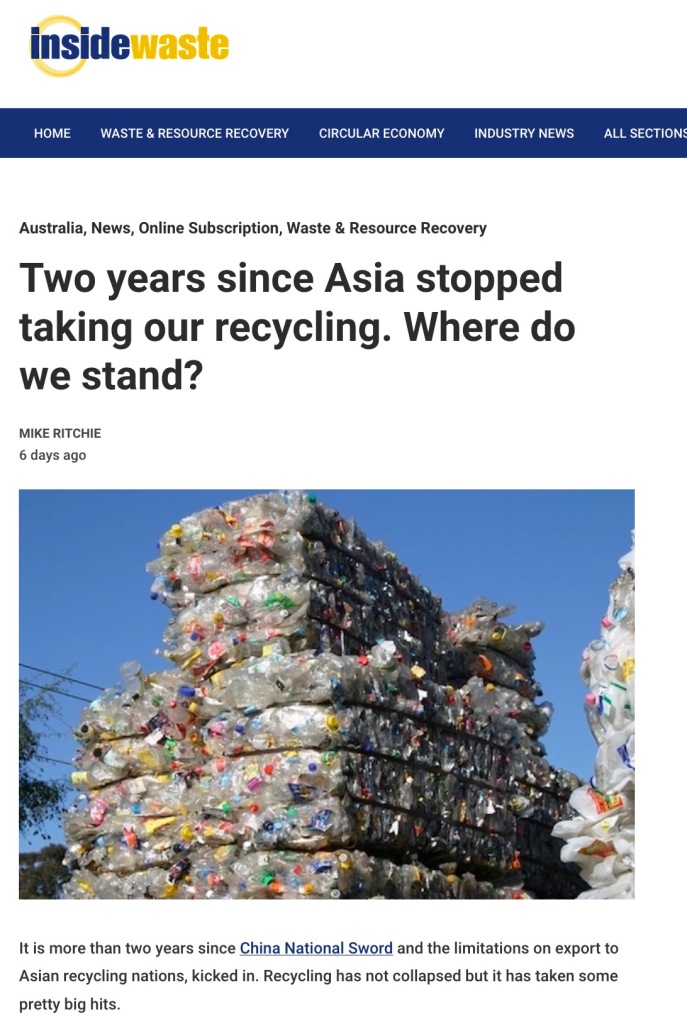2 years since Asia stopped taking our recycling. Where do we stand?
By Mike Ritchie, MRA Consulting Group

It is more than two years since China National Sword and the limitations on export to Asian recycling nations, kicked in. Recycling has not collapsed but it has taken some pretty big hits.
Local Government for the most part has stepped up to the plate and compensated Materials Recovery Facilities (MRFs) for the loss in commodity sales revenue. They should be thanked for that.
So where are we up to now?
Recycling is a very vulnerable sector. We have seen the collapse of SKM in Melbourne with short term stockpiling and landfilling of recyclables. Cleanaway stepped in and bought the SKM assets and has spent the last few months cleaning out old stockpiles and refurbishing equipment. While Cleanaway has always dabbled in “post collection” processing they are now a major player in the MRF market. That can only be a good thing for recycling stability in Australia. (Their Perth MRF burnt down recently but they are already rebuilding).
Polytrade, earlier in the year, announced that it was pulling out of MRF contracts in Sydney and Newcastle. That has sent “SKM like” shockwaves through the NSW recycling industry. So far the affected Councils have rehomed their tonnes with IQ Renew and SUEZ. That pretty much means all MRFs in Sydney are full.
Sydney now has a significant shortage of MRF capacity. VISY’s Taren Point MRF burnt down late last year and it is being rebuilt. Polytrade is closing its Rydalmere MRF. SUEZ operates a small MRF at Campbelltown. So the only large scale MRF servicing Sydney is the VISY Smithfield MRF. If that MRF had an operational problem or god-forbid a fire, Sydney would be in all sorts of bother. There is no Plan B. No contingency.
On the positive side Polytrade has said publicly that they will build a replacement MRF if gate fees increase substantially. I am sympathetic to this view. Polytrade has a site at Enfield with planning and EPA consent. To build it requires a commercial business model that works.
SUEZ lodged planning application documents only last week for a 180,000t/yr MRF at Chullora. That will be a massive boost to Sydney MRF capacity if it is approved. There is every reason it should be.

The collapse of China as a market for recycled product has fundamentally undermined the business model for Australian MRFs in the short to medium term. We “off-shored” secondary reprocessing of recyclate because it was cheaper and more efficient to reprocess recyclate in Asia than in high wage Australia. Furthermore, China and Asia wanted our recyclates more than domestic users and were prepared to pay more for it. That is market economics working efficiently.
In 2019 the Federal Government announced bans on the exports of most recyclates to Asia. These bans, delayed as a result of COVID-19, include glass in January 2021 with plastic, paper and tyres to follow from July 2021 through to July 2024.
The bans demand that we now “on-shore” the secondary reprocessing of MRF recyclate. If we don’t fast-track approvals and the building of such facilities, we will inevitably have to landfill MRF outputs. That would be truly dumb and undermine what is left of the public’s confidence in recycling.
So what will it take to get this investment to happen?
First a further uplift in MRF gate fees. As mentioned above, we have already seen MRFs increase their gate fees (the “uplift”) by about $60-100/t (not including glass. Very little of which was exported).
The average increase has been around $100-120/t when the fall in the value of glass is also taken into account.
It is worth noting that the uplift would have been substantially worse if CDS had not happened at the same time, in particular in NSW. The value of CDS materials somewhat offset the falls due to export market collapse.
A $100/t uplift is equivalent to about $25 per household per year. Most Councils have treated this as an unavoidable cost increase and have willingly paid MRF operators to keep the system running. They should be applauded for this response.
Given the continuing fall in international commodity prices and the need to build and operate (profitable) reprocessing in Australia, MRA modelling suggests we could see a further uplift of around $100-160/t over the next 24 months. That is, a further increase in household costs of $25-40/hh/year.
That may push MRF gate fees to $200/t for metropolitan Councils. Time will tell.
In Sydney landfill costs $350/t, so recycling will still be commercially attractive for Councils. In other capital cities it is more borderline). In rural Australia landfills can be $0-100/t and this will inevitably lead to calls to stop collecting recyclables and landfill them instead. (The Productivity Commission said as much in its last report into waste more than a decade ago).
We hope that Federal and State Governments step up to the plate with infrastructure grants and waste levy rebates to reduce the burden on Councils and ratepayers. If they don’t, then $200 plus MRF gate fees are predictable.
We need to build new plastic, glass, tyre and fibre reprocessing in Australia and to the extent possible develop domestic markets to use it. Banning the export of these commodities without the supporting systems will cause collapse and heartache.
The answer is for State and Federal Governments to hypothecate a serious amount of the landfill levies back into recycling infrastructure and systems. ACOR released a report that found that only 8% of levy funds are actually being spent on their legislated purpose (recycling). Industry is prepared to invest in this infrastructure, in improving recycling, in standardising bins and upgrading MRFs but it needs a profitable business model to do so. At this stage that business model is still pretty wobbly and needs government action.
As always, we welcome your feedback on this, or any other topic on ‘The Tipping Point’.
This article has been published by the following media outlets:




